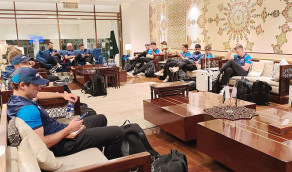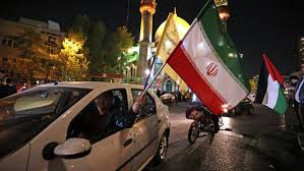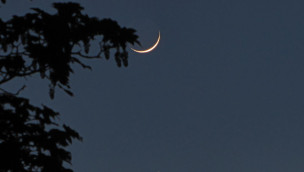NASA, SpaceX launch Crew 3 astronauts to space station
- News By : Web Desk
- 2021-11-11 07:38:43

CAPE CANAVERAL: 11, NOVEMBER, 2021: NASA and private rocket company SpaceX launched four astronauts into orbit late on Wednesday en route to the International Space Station, including a veteran spacewalker.
The SpaceX-built launch vehicle, consisting of a Crew Dragon capsule perched atop a two-stage Falcon 9 rocket, climbed into the night sky from NASA's Kennedy Space Center in Florida, as its nine Merlin engines roared to life at about 9 p.m. (0200 GMT Thursday).
Liftoff of the Dragon spacecraft, named Endurance by the crew, was aired live from Cape Canaveral on NASA TV. Intermittent rain and clouds over the Cape earlier in the day had cast doubt on launch prospects, but the weather cleared by flight time, NASA said.
Live video footage webcast by NASA showed the four crew members seated calmly and strapped into the pressurized cabin of their gleaming white SpaceX Crew Dragon capsule, wearing their helmeted white and black flight suits several minutes after liftoff.
The rocket's reusable lower stage separated from the rest of the spacecraft and flew itself back to Earth, touching down safely on a landing platform floating on a vessel in the Atlantic.
The three American astronauts and their European Space Agency crewmate were due to arrive at the space station, orbiting some 250 miles (400 km) above the Earth, on Thursday evening following a flight of about 22 hours.
The flight marks the third "operational" space station crew sent to orbit aboard a Dragon capsule since NASA and SpaceX teamed up to resume space launches from American soil last year, following a nine-year hiatus at the end of the U.S. space shuttle program in 2011.
"Crew 3" includes two members of NASA’s latest graduating class of astronauts - Raja Chari, 44, a U.S. Air Force combat jet and test pilot serving as mission commander, and mission specialist Kayla Barron, 34, a U.S. Navy submarine officer and nuclear engineer.
Chari, Barron and Maurer were making their debut spaceflights with Wednesday’s launch, becoming the 599th, 600th and 601st humans in space.
Both Chari and Barron also are among the first group of 18 astronauts selected for NASA’s upcoming Artemis missions, aimed at returning humans to the moon later this decade, over a half century after the Apollo lunar program ended.
Earlier, on October 16, China launched second crewed mission in which a rocket carrying three astronauts including a woman, to the core module of a future space station where the three will live and work for six months, the longest orbit for Chinese astronauts.
A Long March-2F rocket carrying the Shenzhou-13 spacecraft, which means “Divine Vessel,” blasted off from Jiuquan Satellite Launch Center in the northwestern province of Gansu at 12:23 a.m. (1623 GMT on Friday).
As per the country's Manned Space Agency, the vessel successfully docked to the port of the space station on at 6:56 a.m. (2156 GMT), and the astronauts entered the space station’s core module at 10:03 a.m.
It is pertinent to mention here that, China started constructing the space station in the month of April with the launch of Tianhe — the first and largest of the station’s three modules. Slightly bigger than a city bus, Tianhe will be the living quarters of the completed space station.
Shenzhou-13 is the second of four manned missions needed to complete the space station by the end of the next year 2022.
In the latest mission, astronauts will carry out tests of the key technologies and robotics on Tianhe needed to assemble the space station, verify onboard life support systems and conduct a host of scientific experiments.
The mission commander Zhai Zhigang, 55, from China’s first batch of astronaut trainees in the late 1990s, said "The most challenging task will be the long-term stay in orbit for six months."
Speaking at news conference on Thursday he said "It will exact higher demands (on us), both physically and psychologically."
The former air force pilot first traveled to space in 2013, to Tiangong-1, a prototype space lab. She is China’s second female astronaut in space, following Liu Yang in 2012. Shenzhou-13 is the first space mission for the third astronaut, Ye.
After the crew returns to Earth in April, China plans to deploy six more missions, including deliveries of the second and third space station modules and two final crewed missions.
Earlier, on September 16, a SpaceX rocket ship blasted off from Florida on Wednesday carrying a billionaire e-commerce executive Jared Isaacman and three less-wealthy private citizens he chose to join him in the first all-civilian crew ever launched into Earth orbit, marking a new era in the space tourism business.
The quartet of amateur astronauts, led by the American founder and chief executive of financial services firm Shift4 Payments Inc, Jared Isaacman, lifted off just before sunset from the Kennedy Space Center in Cape Canaveral, and the spacecraft roared into the darkened skies.
A SpaceX webcast of the launch showed Isaacman, 38, and his crewmates ? Sian Proctor, 51, Hayley Arceneaux, 29, and Chris Sembroski, 42 strapped into the pressurized cabin of their gleaming white SpaceX Crew Dragon capsule, dubbed Resilience, wearing their helmeted black-and-white flight suits.
The capsule roared into the Florida sky perched on top of one of the company?s reusable two-stage Falcon 9 rockets and fitted with a special observation dome in place of its usual docking hatch. The Crew Dragon, fitted with a special observation dome in place of its usual docking hatch, reached orbit almost 10 minutes after the 8:03 p.m. EDT blastoff.
The flight, the first crewed mission headed to orbit without professional astronauts, is expected to last about three days from launch to splashdown in the Atlantic, mission officials said.
The rocket's first-stage booster, after separating from the spacecraft's top half, descended back to Earth and touched down safely on a landing platform floating in the Atlantic on a drone ship affectionately named Just Read the Instructions.
The flight, marking the first crewed mission to orbit with no professional astronauts along for the ride, is expected to last about three days from launch to splashdown in the Atlantic, mission officials said.
It marked the debut flight of SpaceX owner Elon Musk?s new orbital tourism business, and a leap ahead of competitors likewise offering rides on rocket ships to customers willing to pay a small fortune for the exhilaration ? and bragging rights ? of spaceflight. Isaacman has paid an undisclosed sum to fellow billionaire Musk to send himself and his three crewmates aloft.
Isaacman has paid an undisclosed sum to fellow billionaire Musk for the journey. Time magazine has put the ticket price for all four seats at $200m.
Video clips posted on social media showed cheers erupting at the control tower when the Falcon 9 rocket separated from the Dragon capsule about 12 minutes into the flight.
The mission, called Inspiration4, was conceived by Isaacman mainly to raise awareness and support for one of his favorite causes, St. Jude Children?s Research Hospital, a leading pediatric cancer center in Memphis, Tennessee.
Inspiration4 is aiming for an orbital altitude of 360 miles (575 km) above Earth, higher than the International Space Station or Hubble Space Telescope, and the farthest any human will have flown from Earth since the end of NASA?s Apollo moon program in 1972, according to SpaceX.
At that height, the Crew Dragon will circle the globe once every 90 minutes at a speed of some 17,000 miles per hour (27,360 kph), or roughly 22 times the speed of sound. (04)










